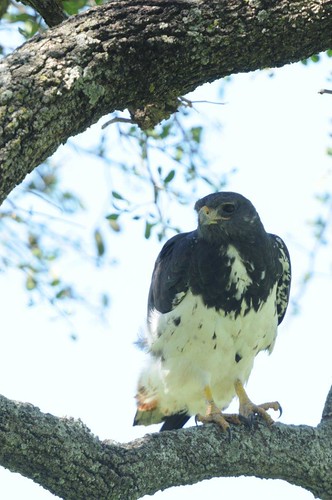tags: Augur Buzzard, African Red-Tailed Hawk, Buteo rufofuscus, birds, mystery bird, bird ID quiz
[Mystery bird] Augur Buzzard, also known as the African Red-Tailed Hawk, Buteo rufofuscus, photographed at the Ndutu Safari Lodge, at the south end of the Serengeti ecosystem, just outside Serengeti National Park, Tanzania, Africa. [I will identify this bird for you in 48 hours]
Image: Dan Logen, 15 January 2010 [larger view].
Nikon D300, ISO 400, 1/250, f/6.3, +2 Exp comp.
Please name at least one field mark that supports your identification.


Head shape and the strong legs/talons suggest a Buteo hawk to me. Beyond that I'd need a good African bird reference.
My guess is that Jana would be better off using her basic knowledge than a good African bird reference.
I think the common name of this bird could be seen as an "expression of oblivion."
Carel, I don't know what that comment meant, or why you commented about me in the third person. Can you clarify?
Agree with Jana--whatever it is, it's a handsome buteo , with feathering down the tarsus.
Just curious-- what would one offer as an "expression of oblivion" ?
My take is that this species of raptor has something to do with the Roman priests whose main role was to look at flying birds and predict the future.
Jana, I'm sorry if I offended you. Believe me, I wouldn't dream of using anything but the second person when addressing you one-on-one. As for my comment, I meant that your understanding of general Buteo configuration served you well--I agree with your diagnosis of the bird's genus, which might have actually been complicated by using an E. African field guide. As for my other comment, it was a rather clumsy attempt at a veiled reference to "Oblivion Express," i.e., I agree with Hai-Ren.
I think that this "boring" bird is a female, indicated by the black feathering on the breast.
Carel - ok, cool. It was just not clear what you were getting at.
Are Augur buzzards sort of like the African red-tailed hawk then, in that their coloration can be anything they darn well please? I looked at a few pictures but none had a hood going as far down onto the breast as this picture shows. Or is it sexually dimorphic, as Adrian suggests?
There's a lot of variation in the amount of dark color underneath on these birds, from totally white to totally black. A number of sources credit them with sexual dimorphism, with females having dark throats and tending to have more heavily spotted flanks, but I'm not sure how reliable that rule is, personally.